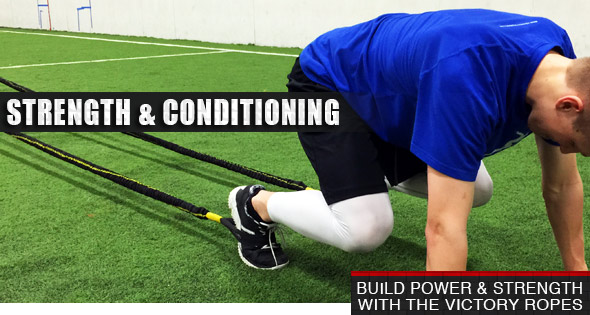Improve Footwork For Larger Athletes | Victory Ropes Angled Sprint Shuffles
The larger the athlete the more difficult it is for them to decelerate from a full speed sprint while maintaining great body control and footwork. Centers, power forwards, and offensive linemen in football are great examples of large athletes who need to move quickly while staying under control.
For a basketball player it could be transitioning from a full sprint down the court into good rebounding position where the athlete is using their hips and footwork to box out an opponent. In football, offensive and defensive linemen must maintain control as they run full speed and use their hands and legs to engage opponents. Athletes who utilize hip exercises to help build great athleticism, body control, and footwork will be more successful when encountering situations similar to these.
The Victory Ropes Angled Sprint Shuffles is a great hip exercise, which will help condition athletes for the duration of competition. This hip exercise drill not only allows athletes to maintain great footwork at the beginning of a match or competition, but the added resistance provided by the Victory Ropes helps to condition the athletes and ensure they are able to maintain great form and footwork late into games.
Utilize Hip Exercises To Maintain Body Control When Moving At Full Speed
There are many game scenarios in multiple sports in which an athlete is forced to quickly accelerate, decelerate, and assume a great athletic position while executing some sort of athletic move. By utilizing hip exercises, which mimic these scenarios, athletes will be able to incorporate this very relevant drill into their athletic training.
The Victory Ropes Angled Sprint Shuffles athletes will need 4 Speed and Agility Cones, Victory Ropes, and a partner. Athletes will first connect the Victory Ropes by running one Victory Rope through the opposite Victory Rope anchor strap, located at the end of each Victory Rope. Athletes will then feed the already looped Victory Rope through one of its own anchor straps and pull tight. Athletes will then create rings for themselves, which they can place around their waist. This will be accomplished by grabbing the middle of the Victory Rope, folding it so the Victory Rope is in a tight loop, feeding this loop through the available anchor strap, then placing this loop around the athlete’s waist. This action will be performed on both Victory Ropes creating a loop for each athlete to place around their waist.
Athletes will place two of the Speed and Agility Cones 20 feet apart, placing the remaining two Speed and Agility Cones 5-8 yards away from the originally placed Speed and Agility Cones and 1-2 yards to the outside of them. This should create a 45 degree angle running to the outside. This means as athletes move from one Speed and Agility Cone to the next they will increase the distance they are from their partner.
Maintain Great Footwork When Fatigued
By utilizing resistance with this hip exercise athletes will not only be able to work on their strength as they run and increase the distance from their partner, but this drill offers a great opportunity to practice great body control and footwork as athletes move from a full speed movement into a more controlled motion. By performing the drill for 30-40 seconds athletes will be able to tax their endurance system teaching them to maintain good body positioning even as fatigue begins to set in late in a game.
To execute the hip exercise athletes will place the Victory Rope loops around their waist and line up at the Speed and Agility Cones which are closest together. Athletes will simultaneously sprint to the opposite Speed and Agility Cone before quickly rotating their hips and shoulders toward their partner and shuffling back to the starting Speed and Agility Cone. Athletes will perform this hip exercise for 30-40 seconds before stopping to rest for 40-90 seconds between sets. Athletes should perform 3-6 sets of the hip exercises being sure to rotate sides the footwork drill is performed on. Rotating the athletes will ensure athletes are maintaining balance as they shuffle left on one side and right on the opposite side.
As athletes perform the hip exercise drill it is important they practice good footwork and perform a good rotation with their hips. Athletes should keep their hips and shoulders facing their partner as they shuffle back to the starting Speed and Agility Cone following the angle of the cones. As athletes transition at each Speed and Agility Cone it is important they take short choppy steps and keep their feet underneath them to minimize any wasted movement or steps. By taking short choppy steps athletes will be able to maintain better body control and make a smoother transition into either their sprint or angled shuffle.
Great Hip Exercises And Footwork Drills For Younger Athletes
Although the Victory Ropes Angled Sprint Shuffles is a great hip exercise drill for athletes of all sizes, it is a conditioning drill which younger athletes may struggle with. Younger and less advanced athletes should utilize plyometric drills such as the Kbands Baseball Power Jumps to help begin to build explosive strength or the Speed Ladder Drills to help build foot speed and body control.
Athletes of all ages and skill levels should incorporate the Resisted Running Drill into the same training session as the Victory Ropes Angles Sprint and Shuffle. The Resisted Running Drill will further develop the hips and legs to be more powerful and explosive as athletes work hard to accelerate their foot speed and elongate their stride length all while enduring Resistance provided by the Reactive Stretch Cord or KB Duo.

